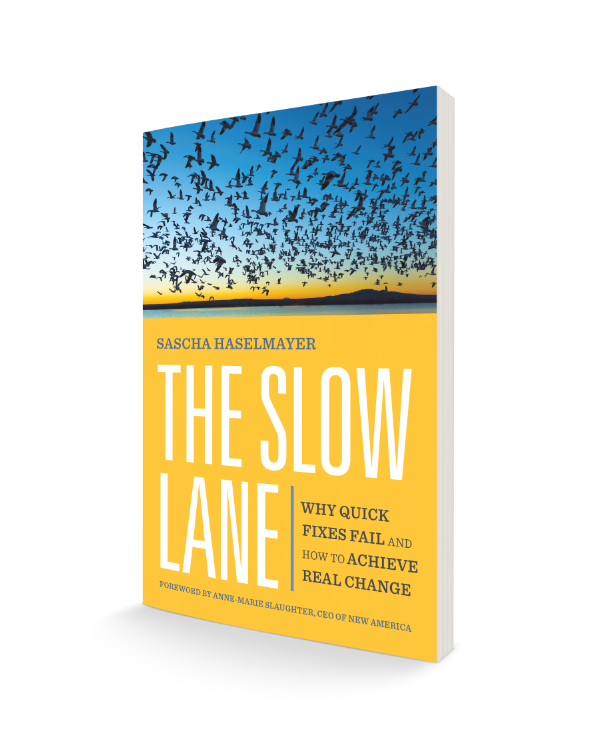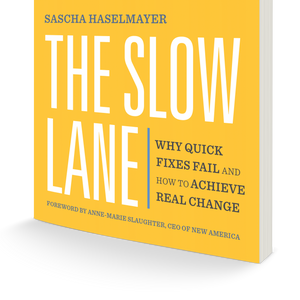After studying more than a hundred Slow Lane movements over the past two decades, I found that what really unifies the Slow Lane is not what they do, but how these movements go about changing things. To avoid the kind of negative effects of the Fast Lane, these slow-laners adhere to a set of principles that guide their actions. My research led me to five Slow Lane Principles that stood out as universal and timeless. You will recognize them throughout the examples in this book. They are simple, but can be practiced in sophisticated ways by people, movements, businesses, organizations, and even governments.
Slow Lane Principle #1: Hold the urgency.
Don’t sacrifice inclusion, participation, or sustainability for the sake of rushing to action. The Slow Lane strives to find solutions for everyone, in keeping with the ancient slogan “Nothing about us, without us”, brought to life by disability activists around the world in the 1990s. Iceland did just that, when during the financial crisis it resisted the impulse to restore the old order, and instead invited citizens to rewrite their constitution. Holding the urgency is to know that rushing to action won't get us there faster.
Slow Lane Principle #2: Listen.
Don’t pretend. Act with the humility to know the limitations of your listening. How you listen reveals whether you intend to treat others as equal contributors. User Voice broke the toxic power dynamics in the probation system by recruiting ex-offenders to do the listening. This kind of listening is essential to build the kind of trust that can change hearts and minds, allow something new to emerge, and keep people involved for the long haul.
Slow Lane Principle #3: Share the agency.
Don’t impose your answers. Create an environment in which even the least prepared people can find comfort and have the capacity, capability, and power to choose freely if they wish to join, contribute and exert their power. User Voice engages and trains prisoners to give them a say in their rehabilitation journey. In the Slow Lane, empowerment is practiced with patience and care, meaning that this invitation meets people where they are, and remains open to anyone, at all times.
Slow Lane Principle #4: Nurture Curiosity.
Don’t lock into a single answer. Curiosity makes the Slow Lane more inclusive and allows transformative visions to emerge. Curiosity lets us unlearn our preconceptions and open up to new ideas. Curiosity also lets us seek inspiration from outside our immediate reality, for example from science or other movements. Without curiosity, User Voice might have become an activist prison rights movement that works against prisons, feeding on frustrated prisoners and their families. Instead, their lived experience and research revealed opportunities to work with prison leaders to improve outcomes for all. Curiosity helps movements retain the flexibility to find common ground.
Slow Lane Principle #5: Use Technology as an Enabler.
Don’t use technology to dominate others. Instead, develop strong human values, principles and behaviors that technology can enable. Successful Slow Lane movements have rewritten the tech playbook to withstand the growth mindsets that reduce complex human needs to what engineers believe they can solve. Tech in the Slow Lane is owned by everyone, and it uses creative new ways to enable the best in human relationships.
In The Slow Lane book, we will see how movements with very different missions have tailored the Slow Lane Principles to their needs, like parenting, data and technology, public service delivery, community development, healthcare, or waste management.
The Slow Lane Principles are used so widely because they give communities the freedom to pursue whatever mission they have. They allow for diversity of thought and mission. They also create the kind of human dynamics we naturally enjoy, and let us change things without doing harm to others.
The Slow Lane Principles make us more resilient in the face of countless challenges and tempting opportunities. As we dive into the stories in The Slow Lane, we will discover the beautiful and sophisticated ways in which these principles have been applied. This is all the more remarkable because the Slow Lane has no prescribed ideology, manifesto, law or regulation. It has evolved as a practice because it works, and comes naturally to so many.
Order The Slow Lane book now!








